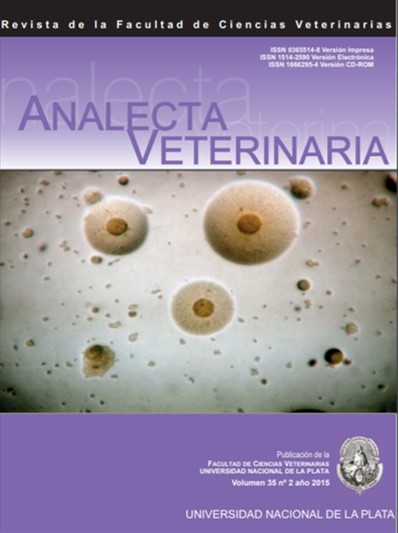Chicken erythrocyte Invasion Capability of a <i>Mycoplasma synoviae</i> Strain isolated in Argentina
DOI:
https://doi.org/10.24215/15142590ep.%2021-24Abstract
Mycoplasma synoviae is one of the most important pathogens in poultry industry and often causes diseases of a chronic and persistent nature. Little is known about the mechanisms of persistence in the host and the strains differ significantly in invasiveness and pathogenicity. A recent study demonstrated the capacity of M. synoviae to invade chicken erythrocytes (CER). The aim of this study was to determine whether a field M. synoviae strain isolated from an Argentinean laying hen farm has the same cell invasiveness capacity. The test used for this purpose was the gentamicin invasion assay. Samples of chicken erythrocytes in vitro infected with the M. synoviae field strain and control infective strains (M. synoviae WVU 1853 and M. gallisepticum, 14102) were taken 2, 4 and 24 hours after infection, inoculated in Frey broth with or without gentamicin, plated in Frey agar and incubated at 37 ºC for 4-6 days. M. gallisepticum 14102 treated with gentamicin grew well in the agar plates after 2 hours of infection. M. synoviae WVU 1853 and M. synoviae field strain treated with gentamicin grew in the agar plates after 24 hours of inoculation. It is very likely that the strains recovered from the infected chicken cells had invaded the erythrocytes and escaped the mycoplasmacidal effect of gentamicin. This study provides the first evidence of nonphagocytic cell invasion capability of a M. synoviae strain isolated in Argentina.
Downloads
Metrics
No metrics found.
Published
How to Cite
Issue
Section
License
Authors retain the copyright and assign to the journal the right of the first publication, with the with the terms of the Creative Commons attribution license. This type of license allows other people to download the work and share it, as long as credit is granted for the authorship, but does not allow them to be changed in any way or used them commercially.

Analecta Veterinaria by School of Veterinary Sciences, National University of La Plata is distributed under a Creative Commons Attribution-NonCommercial-NoDeriv 4.0 International License.

























